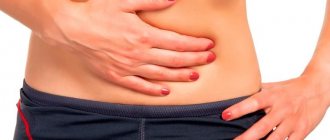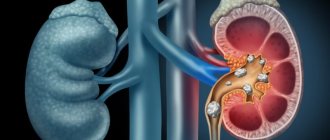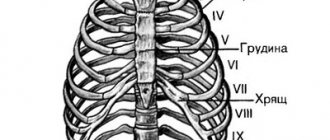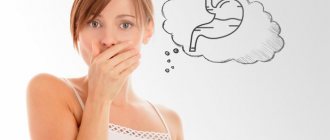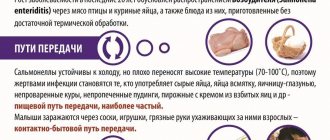It hurts on the right under the rib; this fact is observed not only when the increase in their volume is associated with the onset of inflammation
Very often there are painful sensations that are located under the ribs on the right side. Many people want to know what is under the right rib? Every person experiences them at least once in their life. This occurs as a result of the high density structure of the organs located on that side of the chest. Here the liver and the right side of the kidney are located close to each other.
Pain in the right side is divided into acute and dull. They occur if the liver or kidney does not have enough space allotted to them by nature. This fact is observed not only when the increase in their volume is associated with the onset of inflammation.
The cause of pain may be displacement of internal organs that arise as a result of impact or compression, and they are as close to each other as possible.
To accurately find out the cause of pain in the right side, you need to know what it depends on and what factors influence its occurrence.
What is under the right rib?
In order to determine what is located under a person’s ribs on the right side, let us turn to topographic anatomy.
The right hypochondrium is part of the anterior abdominal wall, which is limited by:
- at the top – projection of the diaphragm (fifth rib);
- below – the lower edge of the arch of the ribs;
- inside - a line passing vertically through the point of the ribs is at the very bottom;
- outside - a line running vertically from the upper protruding pelvic bone (iliac crest).
If we extend the lower border of this area onto the back, we will see that it runs along the 12th rib and the third lumbar vertebra.
You can find out where the right hypochondrium is located in this way: place the palm of your right hand horizontally on the ribs so that the wrist is in the middle of the side, while the edge of the little finger should coincide with the edge of the ribs from below. If we leave the wrist in the same position and clasp the palm of the back, we get a posterior projection of the right hypochondrium.
In this area, pain may occur due to damage to the following organs:
- gallbladder, liver;
- right kidney (upper part);
- large intestine (part of it is the flexure of the colon);
- peritoneal part of the right half of the diaphragm;
- adrenal.
Along with this, in this area, tingling and pain can be reflected from the duodenum, pancreas, inferior vena cava, and bile ducts.
Pain in the right hypochondrium in healthy people, why does it occur?
Sometimes discomfort and nagging pain on the side, behind, as well as pain on the right under the ribs in front can be felt even by a completely healthy person. Such manifestations are associated with certain physiological conditions.
Physical exercise
Pain may appear during the process and as a result of physical activity.
People who are not accustomed to subjecting themselves to strenuous physical activity may notice, after heavy work or sports, that they have severe stabbing pain in the right side under the ribs in front.
The reason for such manifestations is associated with the following process: when adrenaline is released, the tone of the bile ducts decreases, and they are stretched by stagnant bile. Meanwhile, the liver is actively filling with blood, its capsule is stretching, and tingling occurs. There may even be acute pain from the back and front.
Pain after eating, especially a heavy meal, almost always appears in the hypochondrium during physical activity. If it hurts in the right side under the ribs in front, please note that after eating it is especially not recommended to run or do push-ups.
In addition, it is known that it can cause dull pain in the right hypochondrium in front and spasm of the diaphragm. A person feels it when he sighs, sometimes when he inhales and exhales. The same sensations can occur when coughing. But such pain is usually short-lived. Sometimes it becomes dull when pressed. As a rule, if breathing evens out after exercise, this symptom disappears.
However, explanations for why the ribs on the right side hurt are not always true. Sometimes why aching pain appears during exercise, some sources explain the expansion of the inferior vena cava due to the influence of adrenaline and its pressure on the liver.
Before determining what hurts in the right side under the rib, you should take into account that under the influence of adrenaline, vasoconstriction occurs, and there are no pain receptors in the liver.
Pain in women: hormonal imbalance and pregnancy
In the last days of the monthly cycle, a certain proportion of women may develop a sharp hormonal imbalance. As a result, a spasm of the biliary tract develops, and a sharp pain appears, radiating to the back in some cases. Therefore, the explanation for what hurts in the right hypochondrium is sometimes precisely the characteristics of the female body.
In some cases, premenstrual syndrome worsens when taking hormonal contraceptives. In this case, both stabbing and dull pain, as well as burning, appear due to a violation of the passage of bile.
During pregnancy, pain under the right rib in the front is explained by the physiology of the expectant mother’s body.
As you know, during late pregnancy the uterus stretches incredibly. It puts pressure on nearby organs. Therefore, healthy women who experience stabbing in the right side during pregnancy, and also develop numbness in this area, should not worry about why stabbing in the right side during pregnancy.
Consider the fact that the hormone progesterone promotes dilation of the bile ducts and stagnation of bile. It is also very common for pregnant women to experience colitis in the side when running or other activities. Therefore, you should limit yourself to active walks in fresh air at an easy pace.
Pain due to vegetative-vascular dystonia
Vegetative-vascular dystonia is associated with a failure of vascular tone of the blood and is complex in nature. Its frequent cause is psycho-emotional disorders that appear in easily excitable people. One of the signs of weakness is a feeling of pain in the right hypochondrium. It differs in different intensity and nature of manifestation.
When examining the patient, the symptoms of the above ailments are not detected. But people who complain of poor condition sometimes feel severe pain under the right rib in front near the stomach. Such symptoms are called psychogenic. A patient in this condition needs to see a neurologist or psychotherapist who will help alleviate the condition.
Causes of pain in the right hypochondrium
The reasons why a person has a stabbing sensation in the right side under the ribs in front can be associated with a number of different reasons. Only a specialist can determine exactly why it stings under the ribs and aches in the side. But the causes of pain may be associated with the following diseases and conditions:
- a number of liver diseases (causes of pain in the liver - infectious and non-infectious hepatitis, hepatosis as a result of alcohol consumption, fatty hepatosis, cirrhosis, hepatocellular cancer, diseases caused by parasites, metastases in the liver as a result of cancer of the colon, stomach, breast, etc. .);
- heart diseases in which there is circulatory failure in a large circle (myocardiopathy, ischemic heart disease, myocarditis, endocarditis, heart defects), also abdominal variant of myocardial infarction, cardiac cirrhosis of the liver;
- gallbladder diseases (cholecystitis, tumors);
- diseases of the colon (colitis, Crohn's disease, dysbiosis, diverticulosis, intestinal infections, colon tumors, irritable bowel syndrome);
- diseases of the right kidney (kidney abscess, pyelonephritis, polycystic disease, urolithiasis, tumors, echinococcosis, kidney tuberculosis, metastases from bronchogenic cancer, melanoma);
- pathological changes in the right half of the diaphragm (tumors, diaphragmatitis);
- diseases of the right adrenal gland (tumors);
- intercostal neuralgia;
- fractures of the lower ribs;
- shingles;
- conditions in surgery, which are united by the name “acute abdomen” (acute pancreatitis, duodenal bleeding, penetration, perforation or perforation of an ulcer, intestinal obstruction, appendicitis, intussusception, etc.);
- thrombosis of the inferior vena cava (some variants).
Causes
Experts associate right-sided pain with the development of inflammation of organs localized in this part of the body. Less commonly (in about 18% of cases), discomfort causes the formation of a malignant tumor. In 3-5% of situations, an unpleasant sensation in the side is observed in pregnant women (closer to the expected date of birth).
The main etiological factors, favorable conditions for their appearance, as well as common methods of relief are given in the table.
| Etiology of pain in the right side | Why it occurs, what ways to stop it |
| Liver and gallbladder diseases | Unhealthy diet, sedentary lifestyle, alcohol abuse, medication use. Eliminated in a conservative way. If the pain is caused by the formation of stones inside the gallbladder, surgery will be required. |
| Pancreatic diseases | Alcoholism, abuse of spicy, smoked, fatty foods; hereditary predisposition, uncontrolled medication use. Treatment is predominantly conservative. |
| Intestinal diseases | Poor quality and/or infrequent nutrition, previous poisoning, helminthic infestation, smoking, alcoholism, excessive coffee consumption. Other factors are stress and a sedentary lifestyle. Treatment is predominantly conservative. |
| Muscle diseases | Excessive physical activity, hypothermia, monotonous and/or sedentary type of professional activity (pianists, drivers). Treatment is conservative. |
| Intercostal neuralgia | Hypothermia, prolonged stay in an uncomfortable position, sudden jerking movement. Therapy is exclusively conservative. |
| Diseases of the right lung | Hypothermia, the need for prolonged bed rest, work in harmful conditions, sudden climate change, smoking. Pneumonia, including those complicated by pleurisy, is treated conservatively. The malignant process involving the right lung is eliminated surgically, through radiation or chemotherapy. |
| Acute appendicitis | Inflammatory processes in the intestines, the presence of foreign (undigested) objects in the appendix. Treatment is only surgical. |
These include hepatitis, liver cirrhosis, cholecystitis, biliary dyskinesia, and the formation of stones inside the gallbladder. Predisposing factors are unfavorable environmental conditions and anatomical features of the organs of the hepatobiliary system.
Clinical manifestations, in addition to pain localized in the right hypochondrium:
- Bitter taste
- Formation of a viscous white or gray coating on the tongue
- Dyspeptic symptoms – attacks of nausea, vomiting. In 90% of cases, the secreted masses contain an admixture of bile.
- Increase in body temperature to high numbers
- Increased intestinal motility
- Loose stools
Additional signs are a feeling of right-sided heaviness, bloating, tension in the anterior abdominal wall, and an unpleasant sensation when touching it. Against the background of the pathological condition, a decrease in blood pressure occurs, and a pale yellow tint of the skin is observed. If the pain is caused by hepatitis, the pigmentation of the urine increases (it takes on a dark brown tint), and the feces become lighter.
- liver diseases (hepatitis, cirrhosis);
- gallbladder diseases (cholecystitis, cholelithiasis);
- pancreatic diseases (pancreatitis, tumors);
- diseases of the diaphragm (tumor, hernia, diaphragmatitis);
- intestinal diseases (appendicitis, duodenal ulcer);
- heart diseases (myocardial infarction, angina pectoris);
- diseases of the right lung (pneumonia, pleurisy, lung cancer);
- diseases of the right kidney (pyelonephritis, urolithiasis);
- osteocondritis of the spine;
- tumors of all listed organs;
- injuries to the listed organs;
- shingles.
According to statistics, most often pain in the right hypochondrium is caused by diseases of the gallbladder. In second place in the frequency of cases are heart diseases, and in third place are lung diseases.
Pain in the internal organs, which are located in the area of the right hypochondrium, may mean a short-term disruption of their function (spasm), a chronic disease (hepatitis, cholecystitis, colitis, etc.) or a rapidly developing pathology (appendicitis). Pain receptors react to irritation of the organ mucosa, swelling and stretching of tissues, and violation of their integrity.
Sometimes pain in the right hypochondrium occurs in healthy people as a result of physical activity, before menstruation in women. If during physical effort, when inhaling or when coughing there is pain on the right side under the ribs, there is a high probability that it may be cholelithiasis or kidney stones. The load causes the movement of stones, which becomes a possible cause of pain in the right hypochondrium in front.
Pain in the right hypochondrium sometimes occurs in healthy people who do not suffer from chronic diseases. Their causes may be:
- diaphragm spasm after exercise;
- muscle inflammation (myositis);
- bruised or fractured rib;
- intercostal neuralgia – pinched or inflamed nerve.
Diseases of the stomach and pancreas (gastritis, pancreatitis) can also sometimes manifest as cutting or dull pain in the right hypochondrium. The stomach is located closer to the center and left side of the body, but during an acute attack the pain radiates to the right.
If, in addition to pain, there is redness in the area of the right hypochondrium and rashes in the form of blisters, this may be shingles. The disease is characterized by stabbing pain in the right hypochondrium and itching. Shingles is caused by the herpes virus.
On the front side of the abdominal cavity, directly below the ribs, are the vital organs.
The occurrence of acute, aching, spasmodic, throbbing pain in this part of the body can be caused by the following reasons:
- receiving a mechanical injury to the bone tissue of the ribs, the surface of the abdomen, or bruise of internal organs, which occurred as a result of a fall from a great height, blows, or collision with blunt objects;
- the presence of benign or malignant neoplasms in the tissues of the liver and stomach;
- stretching of abdominal muscle fibers;
- stones in the gallbladder, as well as obstruction of its ducts;
- adhesions in the abdominal cavity that arose as a complication after surgery;
- foci of chronic infection that develops in the internal organs of the abdominal cavity;
- pathological tissue processes caused by alcohol and drug abuse (liver cirrhosis, alcoholic or intoxicated hepatitis);
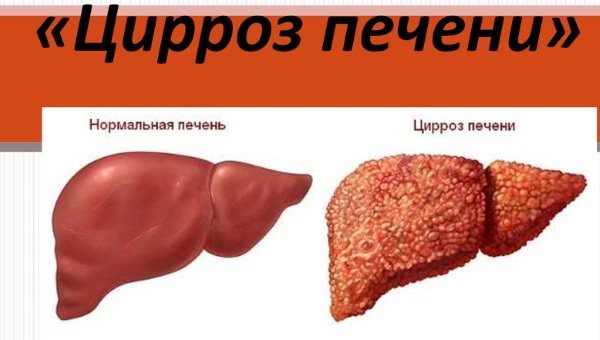
- concomitant diseases of the internal organs of the digestive system.
Pain that occurs in the right hypochondrium in front should not simply be eliminated with the help of analgesics. It is necessary to diagnose the patient’s abdominal cavity as quickly as possible, establishing the cause of the pathology.
When does the front right side hurt?
Tingling or sharp pain in the right side occurs due to diseases of the organs that are adjacent to this area. Some conditions are accompanied by pain from the back, sometimes it radiates to the leg, shoulder blade, kidney, etc. There may also be pain in the lungs when taking a deep breath.
With some diagnoses, pain may be periodic, appearing when walking or coughing. With others, unpleasant sensations bother you constantly.
Liver diseases
As a rule, a dull pain appears in the right side, sometimes the dull pain can be replaced by a bursting pain. Sometimes the discomfort is associated with a feeling of heaviness due to blood filling and swelling of the liver. Something bothers the patient and constant discomfort manifests itself.
If the liver hurts, the reasons for this phenomenon may be associated with stretching of the capsule in which this organ is located. A burning sensation in the liver area is sometimes accompanied by pain radiating to the back, shoulder, and neck. Distention, heaviness and nausea may not disappear throughout the day. Sometimes liver dysfunction occurs due to poisoning, alcohol intoxication, etc.
Hepatitis. If a patient develops hepatitis of any origin, then, first of all, the patient experiences intoxication and dyspepsia. That is, a person feels nauseous, has bloating, pain in the abdominal area, especially after eating. Sometimes it tingles in the right side. In this case, the color of a person’s urine and feces changes, the whites in the eye turn yellow, and jaundice develops.
Cirrhosis of the liver. In patients with cirrhosis, liver cell death and changes in its structure are observed. People with this diagnosis have pain in the right side at the waist level, sometimes the pain is felt in the back.
With cirrhosis, a person may notice pain in the right side below the ribs, already at the very beginning of the disease. At the same time, the burning sensation in the right side is persistent.
In the later stages of cirrhosis, the liver becomes smaller, its performance decreases, the patient develops hepatic coma, and death is likely.
Echinococcosis. The disease is provoked by the worm Echinococcus; as the disease develops, a person develops cysts with fluid inside. As a rule, they form in the right lobe of the liver and gradually compress the bile ducts and capillaries. These are the causes of liver enlargement and pain. Initially, heaviness and discomfort appear in the right side below the ribs. If the cyst ruptures, a liver abscess develops. In this case, there is a sharp pain in the right side. A sharp throbbing pain disturbs when walking, when moving, and radiates to the back. The temperature also rises, and the development of inflammation of the peritoneum and blood poisoning is likely.
Congestive heart failure
Why discomfort in the right hypochondrium in this case is bothersome is explained by the patient’s condition. Initially, his blood circulation deteriorates, as a result, the liver enlarges, and fluid accumulates in the abdominal cavity. A nagging pain appears in the right side, a feeling of heaviness. A nagging pain is disturbing as the disease progresses.
With abdominal myocardial infarction, the patient experiences severe, burning pain in the lower right hypochondrium. Sometimes the patient complains that there is pressure in the side. But in some cases, the onset of pain is sometimes very sharp, similar to the blow of a knife; the pain appears in the shoulder blade and sternum. As a rule, this happens with the development of infarctions of the posterior wall of the heart muscle. Sometimes it seems to the patient that this painful sensation manifests itself in waves: periodically it decreases and intensifies. In this case, pallor, heart rate disturbances, and a drop in pressure may be noted.
Gallbladder disease and flank pain
In such diseases, accompanied by an inflammatory process, stabbing pain in the right side behind appears most often.
Stitching pain in the hypochondrium and in the back develops when a stone has moved and blocked the bile duct. It also develops with acute inflammation - in this case, it hurts in the place between the rectus abdominis muscle and the costal arch on the right. Such pains are cramping and radiate to other places - they appear in the shoulder, in the left hypochondrium. There is also an increase in temperature, vomiting, and belching.
But if the patient has already had his gallbladder removed, but discomfort continues to manifest itself, a natural question arises: what could hurt in the right side under the rib?
If a person does not have a gallbladder, the cause of pain may be the so-called syndrome after cholecystectomy, that is, an exacerbation of other ailments, for example, inflammation of the biliary tract, liver disease, etc. Such patients often note that the side on the right side hurts after eating. This may be due to eating cold food, large amounts of food, fatty, spicy foods, or coffee.
The reasons why aching pain develops in the right side may be associated with chronic cholecystitis. Such patients are worried about dull aching pain in the lower back, nausea, and loss of appetite. There is bloating, bitterness in the mouth, and a headache. Chronic diseases often worsen during pregnancy.
Colon diseases
The answer to the question why the right side of the back hurts and colic appears in the lower abdomen may be associated with diseases of the colon.
The more the colon stretches, the more severe the colic appears. The pain remains less pronounced until the peritoneum is involved in the inflammatory process.
It should be taken into account that in a person’s right side, under the ribs, there is a bend of the colon, that is, only part of the intestine. Therefore, the pain spreads to the entire area around the navel and to the entire right side up to the groin.
It is necessary to take into account, if the right side hurts, that it could also be colitis, which mainly causes spastic pain, stool disturbances, and flatulence.
With nonspecific ulcerative colitis and Crohn's disease, spasmodic pain develops not only in the hypochondrium, but also in all lower abdomen. At the same time, bloating is also noted. People with this diagnosis may develop bleeding, mucus and pus are detected in the stool, the condition is sometimes complicated by intestinal obstruction and intestinal necrosis.
In the case of tumor development, intestinal obstruction is most often observed, there is a picture of an acute abdomen, signs of peritoneal irritation, pressure drops, pallor and cold sweat are observed.
During an attack of appendicitis, pain begins to develop in the epigastrium, after which it gradually spreads to the right hypochondrium and descends to the iliac region on the right.
When to see a doctor
Pain syndrome that occurs in the right hypochondrium can be caused by both ordinary stretching of the muscle fibers of the abdominal cavity and pathological processes. Therefore, if pain occurs, as well as a prolonged feeling of discomfort in this part of the body, you should immediately consult a general practitioner.
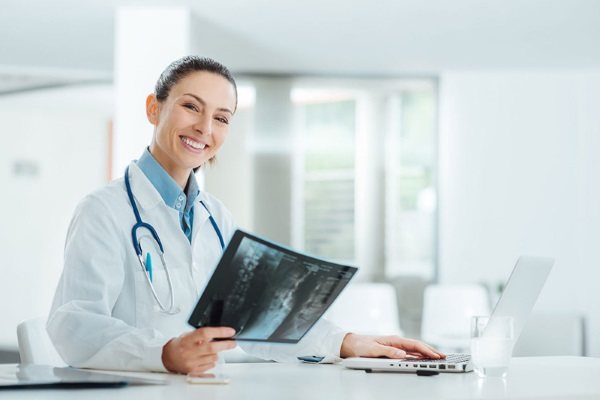
If there is pain in the right hypochondrium in front, then you need to consult a therapist.
A doctor of this profile will perform an initial examination, prescribe tests, or immediately write a referral to a gastroenterologist or surgeon (if there are good reasons for this). Delay in going to the doctor can cause the patient’s well-being to deteriorate and lead to the development of complications.
In case of acute pain, which is accompanied by loose stools, nausea, vomiting and other disturbing symptoms, it is necessary to call emergency help. The cause of this condition may be inflammation of the appendix, blockage of the bile duct or ureter with a stone. In other cases, if the patient is suffering from pain in the right hypochondrium, he should definitely consult a doctor as soon as possible.
The question immediately arises of which doctor to make an appointment with. Everyone knows approximately what is under the right ribs of a person from a school biology course, but it is impossible to determine which organ is unwell, so you need to make an appointment with a general practitioner or therapist. After examination and research, if necessary, he will give a referral to a specialist: a surgeon, traumatologist, cardiologist, neurologist, infectious disease specialist or other specialized doctor.
Manifestation of pain in the right hypochondrium behind
When a patient complains that there is pain in the back under the right shoulder blade, the reasons for this may be associated with injuries to the lower ribs or damage to the intercostal nerves. Pain appears from behind under the right shoulder blade from the back and with lesions of the right kidney and adrenal gland. The causes of back pain may also be associated with diseases of the inferior vena cava.
Urolithiasis disease
Burning and severe pain can bother people with urolithiasis. When moving, stones or sand scratch the renal pelvis, and later the ureter. Consequently, with renal colic there is pain in both the lateral abdomen and the lower back. Painful attacks are observed, spasms radiate to the genitals, to the thigh, and is felt in the groin. If you hit the lower back a little with the edge of your palm, it hurts even more, and blood may appear in the urine. Sometimes vomiting occurs.
Pyelonephritis
The development of acute infectious inflammation of the kidney is accompanied by pain in the kidney area, intoxication, and fever. It also hurts when urinating, periodic false urges are noted, and swelling appears on the face.
With apostematous pyelonephritis, purulent inflammation develops in the kidneys. I am concerned about prolonged nagging pain, the temperature increases, and the amount of urine excreted per day decreases.
Necrosis of the renal papillae
This phenomenon becomes a consequence of oxygen starvation of the kidney tissue if the vessels become clogged. Constant pain is accompanied by the appearance of blood in the urine. There is a possibility of death from septic shock.
Acute upper paranephritis
The inflammatory process of fatty tissue in the area of the upper part of the kidney manifests itself as a consequence of infection from carious teeth, tonsils, etc. First, the patient’s temperature rises and there is moderate pain in the lower back. After a few days, there is already pain in the right hypochondrium, the pain intensifies with a deep sigh, the condition worsens and physical efforts - pain is noted when moving, walking, sharply straightening the body.
Kidney cancer
This condition may not appear for a long time. Mild pain and bleeding appear already in the last stages of the disease. Sometimes the tumor interferes with the outflow of urine, then acute pain is noted.
Pain in the hypochondrium also occurs with tumors of the right adrenal gland, provided that the tumor is large.
Intercostal neuralgia
The reason that a person’s right side feels tight and numb in the hypochondrium area may be intercostal neuralgia. In this state, sometimes there is a pulling from the back, the ribs hurt on both sides in front. With neuralgia, there is a strong tingling sensation in different areas, even to the point of limited mobility. The pain becomes stronger when bending or turning. Also, the cause of a sudden tingling sensation in the pit of the stomach or twitching on both sides can be myositis, when a person’s muscles are inflamed.
Bruised ribs
Severe aching pain, aggravated by coughing, pressing, bending, sighing, occurs with bruises of the posterior segments of the ribs. When rib fractures occur, a characteristic crunch is felt.
Osteochondrosis of the lumbar region
If there is muscle tightness, limited mobility, signs of tension, pain in the right shoulder, in the arm, then the causes of this condition may be associated with osteochondrosis of the lumbar region. Painful sensations can have different intensities, be both aching and shooting in nature, and appear above and below.
Shingles
In this case, herpetic eruptions appear along the nerve in the form of bubbles with cloudy liquid, and the skin turns red. Itching, burning, and pain develop at the site of the lesion. This means that you need to see a dermatologist.
Vena cava thrombosis
If a blood clot comes from the iliac veins, after which it clogs the vein trunk, pain occurs in the lower back on the right side of the back. The clinical picture is similar to that of a late-stage kidney tumor. If thrombosis of the liver segment occurs, intense bursting pain occurs in the front in the right hypochondrium and radiates under the scapula on the right. Jaundice also develops and fluid accumulates in the abdominal cavity.
The pain is acute
The sensation of acute pain in the right lobe of the hypochondrium is associated with the development of acute surgical conditions - the so-called “acute abdomen”. In particular, severe pain is observed in the following diseases and conditions:
- damaged internal organs (injury to the kidney, colon, kidney, damage to the gallbladder, hematoma of the kidney, liver);
- intestinal perforation, diverticulum ruptures;
- acute inflammatory processes of the gallbladder, acute pancreatitis;
- initial stage of appendicitis;
- blockage of the bile ducts, intestinal obstruction;
- thrombosis of the veins and arteries through which nutrition of internal organs occurs.
In such conditions, very intense pain develops, which leads to the development of painful shock, loss of consciousness, decreased blood pressure, and disruption of the functioning of internal organs.
With an acute abdomen, the abdominal muscles are tense, sometimes the pain is girdling, sometimes it’s pinpoint pain, but very often it’s unbearable.
Acute, compressive pain also occurs in the abdominal form of myocardial infarction, renal colic, and sometimes in nonspecific ulcerative colitis and rib fractures.
Pain differentiation
Depending on the pain felt by the patient who consults a doctor with this problem, it is possible to identify which organ disease is associated with certain painful sensations.
So, pain in the right hypochondrium, what could it be:
- Burning pain in the right hypochondrium is often the cause of acute cholecystitis.
- Acute pain in the right hypochondrium is most likely associated with diseases of the gallbladder.
- Severe pain in the right hypochondrium is usually felt by patients suffering from hepatitis.
- Dull pain may be a consequence of inflammatory processes in the gallbladder.
- Aching or pressing pain can be classified as symptoms that occur with biliary dyskinesia.
- Nagging pain is characteristic of chronic hepatitis.
- The bursting type of pain can be caused by chronic diseases of the pancreas.
- Throbbing pain is typical for patients diagnosed with pancreatitis.
- Stitching pain is observed in patients with problems with the right kidney.
Also, pain in the right hypochondrium can only occur in the evening or at night. As medical practice shows, constant night pain in this area is often the first sign of a duodenal ulcer.
Dull pain
Dull pain very often indicates the development of an inflammatory process. They manifest themselves in the following pathologies:
- hepatitis in acute and chronic form;
- liver cancer, cirrhosis, parasitic lesions of the right lobe of the liver;
- period between exacerbations of cholecystitis, cholangitis;
- adrenal tumors;
- intestinal diverticulosis, colitis;
- hydronephrosis, pyelonephritis, late stage of kidney tumors, apostematous nephritis.
In the iliac region there is constant pain due to tumors, metastases of internal organs, rib fractures, and parasitic liver cysts.
Heaviness in the right side
Heaviness in the right side and lower abdomen, as well as in the upper abdomen, develops with various diseases. Often, heaviness in the right side under the ribs in front develops with an edematous liver. In addition, the causes of heaviness in the right hypochondrium may be associated with the development of hepatitis, fatty hepatosis, chronic cholecystitis, and hypomotor biliary dyskinesia.
After meal
Many people note that they have a tingling sensation in their right side after eating, heaviness in the epigastrium and rumbling develop. Often expectant mothers are also interested in why it hurts in the right side during pregnancy.
After eating food, the process of secretion and movement of bile in the body accelerates, the liver fills with blood, and peristalsis is activated. Therefore, with chronic diseases of the liver, intestines, and gall bladder, pain in the lower and upper abdomen often appears after eating.
Such manifestations can have a different character: a person feels sick, belches, diarrhea, constipation, and his stomach growls.
Dull pain after eating is observed with cholecystitis, sharp pain with colitis and dysbacteriosis, stabbing pain with cholelithiasis and biliary dyskinesia. Often the pain becomes more intense after heavy drinking or heavy smoking.
After load
Unpleasant sensations in the form of nagging or stabbing pain occur after physical exertion in people with hepatitis, cirrhosis, or congestive liver. After shaking or physical exertion, an attack of calculous cholecystitis may occur.
Also, periodic pain during exercise appears in patients with myositis, intercostal neuralgia, osteochondrosis, rib fractures, and vena cava thrombosis.
Pain in the side after eating or exercising

Unpleasant one-sided sensations after eating are caused by the presence of inflammation of the stomach, duodenum, and parts of the hepatobiliary system. Also, pain on the right is one of the clinical manifestations of the initial stage of peptic ulcer disease.
Discomfort after physical activity causes:
- Irregular training (excessively intense and/or frequent exercise)
- Eating a large meal the night before
- Incorrect breathing technique during training
- Accumulation of lactic acid inside the muscles
- Fullness of the liver with blood
In all cases, it is advisable to review the training regimen and consult with a specialist. If, despite the adjustments made, the pain recurs, you should definitely undergo an examination. The presence of an inflammatory and/or tumor process cannot be ruled out. With the progression of such, physical activity is not the cause, but an indicator of the pathological process. It confirms the presence of a disorder in the body.

